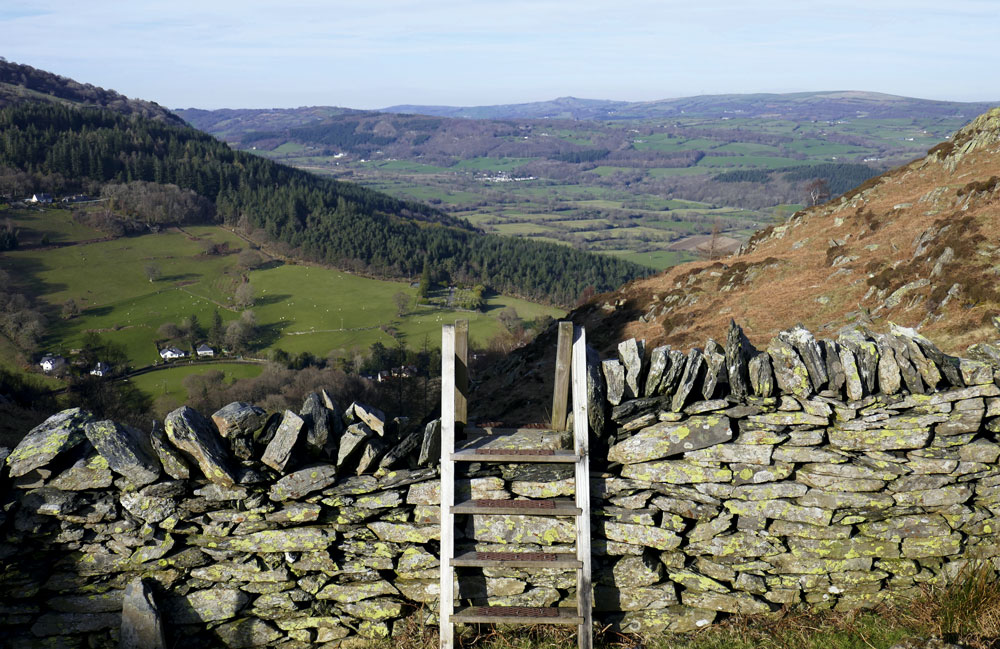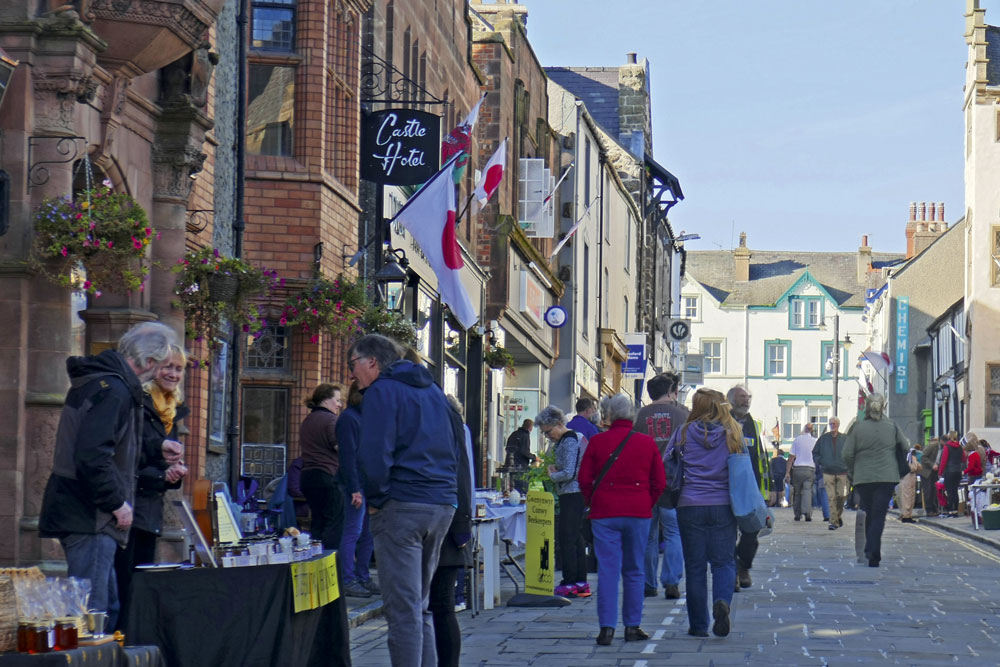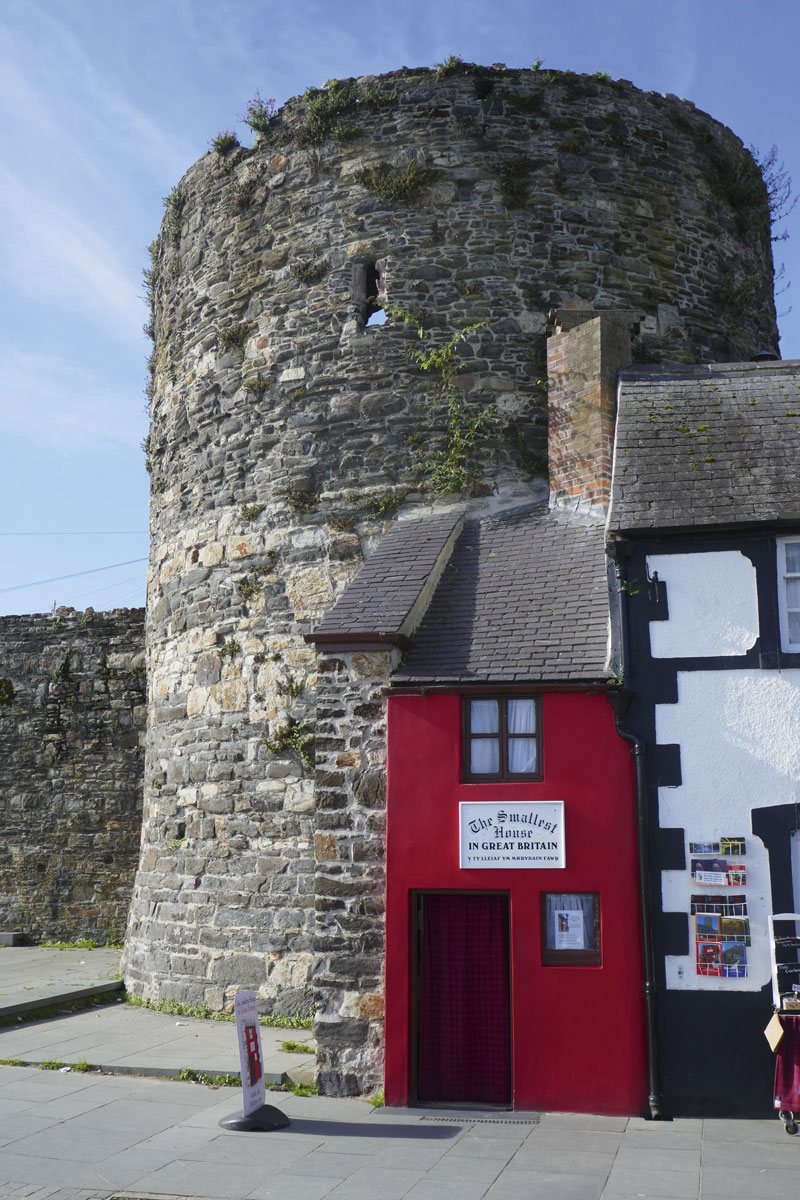Motorhome travel: A weekend in Conwy
Words and photos: Carol Kubicki
Having a list of ideas for short breaks to whip out in the unlikely scenario that we can’t think of where to go can be useful. Checking my list, I was reminded about the Conwy Honey Fair held every year in September. This looked like a perfect summer break, combining walking in the lovely Conwy Valley with being Pooh for a day and filling the honey cupboard. As AA Milne wrote: ‘Winnie-the-Pooh finds comfort in counting his pots of honey...’
Just after crossing the Welsh border is a tea shop I like to frequent when we are heading this way. In the village of Hawarden is the Gladstone's Library, the only Prime Ministerial library in Britain. We don’t visit the library although, from photographs, it looks amazing, but the car park has plenty of room and the grand Gothic building, built after William Gladstone’s death, has a welcoming café. With good coffee and cakes, we like to relax in the stately panelled room or, when it is sunny, in the attractive garden.
The weather forecast hadn’t been promising for our trip, but the Welsh honey fairy was working her magic and the sun popped out as we arrived in the Conwy Valley. In Trefriw we checked out the woollen mill before heading off for a walk.
The mill is a family business that has been weaving stunningly colourful traditional fabrics since 1859 and the shop is an emporium of Welsh gifts. The clickety-clack of the vintage machines that they still use and the rustic baskets of raw and spun wool are evocative of the past and visitors can watch demonstrations.
Walking in Trefriw

Using the Conwy Valley Sacred Trails leaflet of walks between traditional chapels and churches, I was keen to find the nearby St Rhychwyn’s Church tucked away among the lanes at Llanrhychwyn. From Trefriw we climbed up through woodland and by sleepy cottages and remote farms to St Rhychwyn’s, reputedly the oldest church in Wales.
These old Welsh churches are not showy buildings with tall spires; the little stone churches nestle in the hilly landscape and encourage quiet contemplation, rather than awe. St Rhychwyn’s is a splendid example, with a charming wooden door and a simple interior. By now the weather had brightened up so much that we spontaneously decided to return the long way back to Trefriw by the scenic Llyn (lake) Geirionydd, reminding me what a pretty part of Wales this is.
Cefn Cae Camping Site is tucked under hills in the village of Rowen and makes a great walking base. We had a free day before the excitement of the Honey Fair and the verdant Conwy Valley at our feet.
On a fine morning we set off on an ambitious route that would take in more churches on the Sacred Trails as well as a National Trust garden. We popped into the airy nineteenth century chapel in Rowen first, then encountered some difficulties following the trail to Llanbedr-y-Cennin. We were quickly lost on meandering paths through fields and woods. More by luck than signposting we reached St Peter’s Church in Llanbedr-y-Cennin (meaning St Peter’s among the daffodils), a picturesque building with a colourful, well-kept garden.
The route finding was easier to Caerhun Roman Fort. Built to guard a crossing of the River Conwy, only the outline of the fort remains with the delightful walled St Mary’s Church sitting in one corner. Entry is through a narrow lychgate, which forced mourners to access the church by climbing the stone steps over the high wall when a coffin filled the lychgate – not the most dignified entrance!
After crossing the River Conwy at Tal-y-Cafn we tackled the climb to Bodnant Garden. Bodnant felt busy after the peace of the village churches. The garden is beautifully managed by the National Trust and makes fantastic use of water and reflections. We explored all of its corners, breathing in the sweet scent in the rose garden and enjoying different vistas over the valley. Bodnant is vast enough to swallow the crowds and everyone can find a secluded bench to call their own.
We followed the warren of narrow lanes back to the campsite and grabbed a brew before climbing up to the hillside church, St Celynnin’s, at Llangelynnin, in the early evening. The steep woodland path eventually opens onto an ancient walled track that leads to this beautifully situated church.
The attractive medieval stone church sits above the Conwy Valley and the land of Helig ap Glanawg, a legendary sixth century prince. Welsh myth tells that, after his land was flooded by the sea, the prince’s family scattered. Many of his sons embraced a religious life, including Celynin here at Llangelynnin and Rhychwyn above Trefriw.
I walked the perimeter wall, finding the well in one corner and chatted to two horse riders who trotted by on an evening hack. In the setting sun we climbed a knoll for panoramic views of the landscape bathed in golden light before heading back to the campervan, weary after clocking up 14 miles.
The Honey Fair in Conwy
On the day of the Honey Fair we were in Conwy by 9am. Crowds were already arriving. It is over 700 years since Edward I granted Conwy the right to hold a Honey Fair on 13 September.

The Conwy Beekeepers’ website records that, in 1905, it was flourishing with 80 participating beekeepers. In 1926 the fair was packed due to coinciding with the centenary of Thomas Telford’s elegant suspension bridge across the river.
Unfortunately, by 1983 the fair had dwindled to just one stallholder. Since then, hard work has revived the tradition and, in 2018, there were stalls for 30 honey producers alongside those for other local crafts.
Strolling down the street, with stalls on each side, I marvelled at how much effort had gone into their decoration. There were bee-themed tablecloths, pretty honeypots and stuffed bees bringing the displays to life.
Yet, as Winnie-the-Pooh knows, it is the honey that is the star of the show. The beekeepers range from those with a few jars to sell and others with a variety of professionally presented honeys. I was finding it difficult to decide which to buy!
Fortunately, most offer tasting to help customers choose. High from eating so much sugar, I bought distinctive heather honey from the Welsh moors, Trefriw honey from stallholders who taught me how to pronounce the town’s name (f is pronounced v and iw as ew). Honey mixed with roasted hazelnuts was a perfect gift for a porridge-loving friend and sweet-smelling honey soap made a nice treat.
The beekeepers were as keen to chat as to sell their honey and I found this just as much fun as tasting and buying.
At the National Beekeeping Centre’s stall I learnt how they help people deal with unwanted swarms of honey bees by rehoming them. Their favourite tale was the call from an agitated telecoms engineer who had opened a green cabinet, found it full of honey bees and quickly retreated!
Quay House - the smallest house in the UK
Eventually we tore ourselves away and, on Conwy’s quay, bought delicious local Parisella’s ice cream and rested near Quay House, the smallest house in the UK. Along the quay visitors were taking harbour boat trips, buying mussels or just sauntering. While we ate, we watched a party of Chinese students happily gathering for a group photograph in front of Quay House.

The Welsh-costumed woman who manages the visitors to the house looked on; only three visitors are allowed at a time in to the tiny property. She would have had quite a queue if they had all wanted to visit.
There is more to Conwy than just the Honey Fair and, fortified with honey and ice cream, we set off to explore, starting with the medieval walls.
Amazingly, these have survived centuries of railway and road building and Conwy still feels like a fortified town.
The three-quarter-of-a-mile undulating route around the walls passes 21 towers and rewards walkers with changing views.
We gazed over bobbing boats on the estuary, admired the awe-inspiring castle across the town and peered into back yards and gardens.
“Can you answer a question?” asked a couple also following the walls. They wanted to know which came first, the houses or the walls? This is a good question, although they were pointing to the nineteenth century terraced houses that replaced the medieval buildings inside Conwy’s walls. Edward I built the walls, along with the castle, in the late thirteenth century and few medieval buildings survive. Only the original structure of St Mary’s Church pre-dates the town walls.
Heading back for a last browse of the Honey Fair, the streets were now packed with customers and some of the stalls had already sold their stock. We returned home happy to see a Welsh tradition flourishing and with enough jars of honey to keep even Winnie-the-Pooh satisfied – at least until next year’s Honey Fair!
This article was originally published in the August 2019 issue of MMM magazine - click here to buy a digital edition of it, or to order other digital issues.








Recent Updates
Engine management lights: all you need to know
What is the engine management light? What does it mean, and what do I have to do? ...
Motorhome air suspension: all you need to know
Motorhomes are heavy and the additional weight of equipment and height of the bodywork can increase the loads ...
Motorhome WiFi: how to get better motorhome internet
Staying connected on the move is more and more essential, so relying on campsite WiFi isn't an option – here ...
A class of their own - our guide to A-class motorhomes
Thinking of trading up to an A-class, or even going straight to the top of the motorhome tree? We guide you ...
Explore overseas on a motorhome dream tour
Enjoy exotic travel in a campervan or motorhome by hiring, swapping with someone else or exporting your ...
Motorhome water systems: everything you need to know
On-board water is an important part of every motorhome – here’s everything you need to know ...
Campervanning in Europe: what you need to know
Whether you're planning a leisurely drive through the French countryside, navigating bustling city streets in ...
Campervan security: all you need to know
With thefts on the increase, it’s important to know how to keep your campervan secure and prevent campervan ...
Campervan furniture: everything you need to know
Our campervan experts guide you through all the essentials for your campervan, including tables, chairs, ...
Campervan finance: how to fund your purchase
Here we look at the different types of campervan finance available, to help you decide what’s the best option ...
Other Articles
Britain’s best used motorhomes
Want a great motorhome without paying the premium for a new one? Here's a guide to the best you can get in the pre-owned market for each layout, ...
Which motorhome? Choosing the perfect motorhome for you
Choosing a motorhome or campervan is one of the biggest buying decisions you’ll ever make, so it's important ...
Campervan washroom essentials: stay fresh on the road
Our guide will take you through the campervan washroom essentials you'll need so you're well-prepared for ...
Dogs in campervans: all you need to know
Follow our advice and your dog will enjoy campervanning as much as you do ...
Electric campervans: all you need to know
Our guide will take you through everything you need to know about electric campervans and what the future ...
Motorhome electrics: a complete guide to your motorhome electrical set-up
Motorhome electrics can dramatically enhance the convenience and comfort of your vehicle – but they can be ...
Lighting for campervans: all you need to know
We guide you through all the lighting options available for you and your campervan, including interior ...
Electric bikes for motorhomes: our ultimate guide
Read our comprehensive guide to electric bikes for motorhome owners, helping you add electric power to your ...
Our guide to 'cheap' motorhomes in 2024
If you're on the hunt for an affordable new motorhome, this is the best place to start – we've rounded up a ...
Campervans in winter: all you need to know
Here's your guide to preparing your campervan for the colder months, whether you will be using it or putting ...